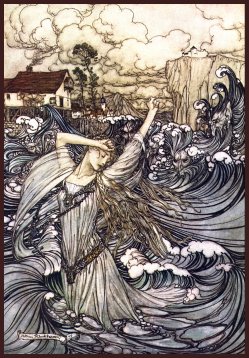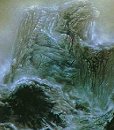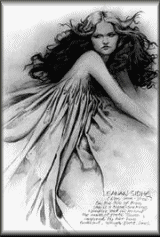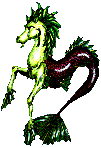|
|
|


These are the elemental
spirits of water. Their magic centers upon this element, whose course
and function they can control. Undines exist within the
water itself and cannot be seen with normal human vision. Their
homes are typically within the coral caves in lakes or upon the banks
of rivers, though smaller undines may choose to live under lily pads.
Their appearance is similar to human beings in most cases, with the
exception of those living in smaller streams or ponds. Undine
clothing is shimmery, reflecting all the colors of water though
green is typically the predominant color.
Every body of water is home to undines, from ocean waves, to rocky
pools, to marshlands, to rivers, to lakes and ponds. Even waterfalls
and fountains have an undine living in their midst.
Bane of seamen, these
half-fish half-women lured countless sailors to their deaths.
Breathtakingly beautiful humans from their torso-upwards,
their lower bodies where those of fish, complete with scales.
Men find their songs irresistible and follow them willingly
into the sea. Mermaids can be caught and held in exchange
for the wishes they grant. The males of the species, Mermen,
are regarded as vicious creatures who raised storms for the
purpose of sinking men's ships.
Occasionally they are successfully courted by human men.
The offspring of such pairings are often granted great powers in
healing by their mothers. Johnny Croy and his Mermaid Bride The shapeshifting selkies,
who are also known as silkies or roane (Gaelic for seal),
occupy the seas surrounding the Orkney and Shetland isles.
The exact nature of their undersea world is uncertain, though
some believe it to be encased in giant air bubbles. Their
true forms are those of faeries or humans, though they take
the form of large seals when traveling the through the oceans.
In particular: great seals and grey seals are
said to take human forms. Older tales tell that selkies are
only able to take on human forms on certain nights of the year,
such as Midsummer's Eve or All Hallows.
Occasionally they encounter humankind, sometimes becoming
their mates. A human male may take a selkie female as his wife
if he finds her seal skin on the beach and hides it from her.
In the end she always recovers the skin and returns to the sea,
though she may return occasionally to watch over her human family
from the safety of the waves.
A human woman may bear the child of a selkie male if she weeps
seven tears or seven drops of blood in the nighttime sea. Such
relationships are rarely lasting. Seven years hence, the selkie would
return for his child, offering the mother a fee for nursing her own babe.
Mermaids

Selkies

Fir Darrig

The Fir Darrig, pronounced "fear dearg", is an Irish fairy, though its original
home may have been Scotland. Translated, the name means "red man." They are
also known by the name Rat Boys, largely due to their appearance; they have
dark, hairy skin, long snouts, skinny tails and are rather fat. Even their
clothing looks as though it might have been scrounged from a sewer, being
extremely torn and shabby.
Some legends hold that the Fir Darrig is an unlucky former human who wandered
into fairy land by mistake and now attempts to warn others from making the same
mistake. Despite this apparently good natured move, they revel in cruel and
gruesome pratical jokes, which they play upon those who have made the mistake of
irritating them. Possessing a similar lack of taste in their choice of
foodstuffs, Fir Darrigs consume carrion as their main staple.
Most active in winter, and found along polluted coastlines, in swamps, marshes
and coastal ruins, it is best to avoid these creatures at almost any cost.
Occasionally they venture into the land of humans, where they delight in
startling people by knocking upon their doors in the dead of night and asking to
warm themselves at the fire. Never refuse such a request, as it is exceedingly
bad luck and you may wake to find a changeling in your child's crib or that your
cows have come down with the pox. Should you happen to encounter a Fir Darrig,
take great pains to be polite to it lest you become the victim for one of its
practical jokes.
Beansidhe

One of the most dreaded and best known of the Irish faeries is the Banshee,
properly named the Beansidhe literally, "woman fairy." The Irish have many
names for her (perhaps they feared invocation of her true name may invoke her
presence?). They included: Washer of the Shrouds, Washer at the Banks, Washer
at the Ford and the Little Washer of Sorrow. The Scottish called her Cointeach,
literally "one who keens." To the cornish she was Cyhiraeth and to the Welsh
either Cyoerraeth or Gwrach y Rhibyn, which translates as "Hag of the Dribble"
(to the Welsh she sometimes appear as a male). In Brittany her name is
Eur-Cunnere Noe.
The Beansidhe is an extremely beautiful faery, possessing long, flowing hair,
red eyes (due to continuous weeping) and light complexions. They typically donn
green dresses with gray cloaks. Their wailing fortells of a death nearby,
though it never causes such a death (which is why they are wrongly feared).
Some of Ireland's oldest aristocrachy could boast of banshees dwelling nearby
their ancestral homes.
If one heard the wailing of the beansidhe and discovered candles burned in a
winding pattern (like a shroud) later that evening, they knew the death was to
occur in their household. In Scotland she squats near the door of the one
doomed and in Cornwall her figure flaps her wings against the glass of the
window belonging to s/he who would die.
As her other names might suggest, she frequently appears as a washerwoman at the
banks of streams. In these cases, she is called the Bean Nighe (pronounced
"ben-neeyah"). The clothing she washed takes different forms depending upon the
legend. Sometimes it is burial shrouds, others it is the bloodstained clothing
of those who will soon die. This particular version of the Bean Sidhe is
Scottish in origin and unlike the Irish version, she is extremely ugly,
sometimes described as having a single nostril, one large buck tooth, webbed
feet and extremely long breasts, which she must throw over her shoulders to
prevent them getting in the way of her washing . Her long stringy hair is
partially covered with a hood and a white gown or shroud is her main wardrobe.
The skin of the Beansidhe is often wet and slimy as if she had just been pulled
from a moss covered lake. They are rumored to be the ghosts of women who died
in childbirth and will continue to wash until the day they should have died.
The keening music of Irish wakes, called caoine, is said to have been derived
from the wails of the Beansidhe.
Leanan Sidhe

The Fairy Mistress or
Fairy Sweetheart, Leanan Sidhe (lan-awn shee), is a Celtic muse
possessing a dark unearthly beauty. Her names translates directly as
My Inspiration (Leanan) Faery (Sidhe). She is sometimes called
Lhiannan-Shee (lannan-shee). Legend says she resides under the Irish
Sea off the eastern coast of Ireland and roams sometimes roams the
Isle of Man at night as she searches for a new lover.
Her lovers are frequently artists, and all who fall under her
spell suffer a keen longing in her absence. In return for the depth
of emotion she receives, she inspires genius in her loves. They have
been likened to candles burning at both ends: incredibly bright, but
lacking the endurance of that which burns normally they expire quickly.
Such is often the price of her gift, though it usual results from a
great heartbreak or sorrow when she leaves, rather than a malicious
intent on the part of the Leanan Sidhe.
While the artist in question typically considers her attentions a
gift, the self destructive nature of the artists once she has left
seems to have inspired a belief that the Leanan Sidhe is evil and
dangerous. Some have even likened her to a vampire, attached to one
man as she ruins his body and soul.
Radiantly beautiful to her lover, she is invisible to all other
mortals. So beautiful, in fact, that all other mortals become
lifeless and dull when compared to the Leanan Sidhe.
Kelpies

Kelpies have their origin
in Scotland, though they are also part of northern Irish faery lore
where they are called Eisges (Ech-ooshk-ya) or Fuath (Foo-ah). The
Cornish call them Shoney which is derived from the Norse name Sjofn,
meaning a Goddess of the Sea. Those in Iceland know them by the name
Nickers, being related to the Nix (who are German water sprites). In
Shetland and the Orkney Islands they are called Nuggies.
These foul-tempered denizens of the fae are rarely seen today, a
fact which is a blessing as humans are among the favorite meals of
these cannibalistic faeries. When other faeries or humans were
unavailable for dinner, Kelpies chose deer who had wandered too close
to the lochs.
Irish lore describes them as web-footed water spirts, who possess
the manes and tails of horses and the bodies of women. In Scotland
they appear as friendly seahorses who allow passing humans to mount
them, drowning their hapless victims once they're away from the
shore.
They are able to shape change, occasionally appearing as humans
though they can be distinguished by their seaweed hair which they are
unable to change.
Kelpies may be captured by placing a bridle over their heads,
though it was a difficult and dangerous task due to the beasts strong
and willful nature. However, if a person managed to accomplish this
task the kelpie was forced to serve the one who bridled it.
|
Unimplemented ISML Tag: TYPE= |
